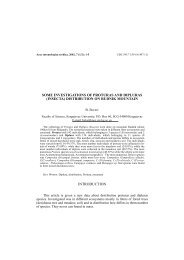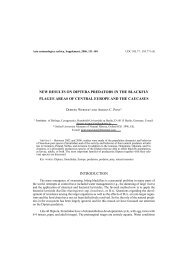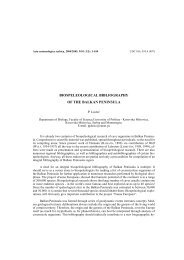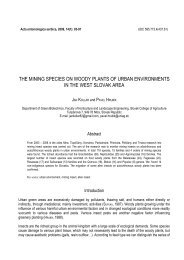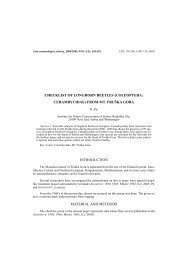Ćetković, A., Mokrousov, M., Plećaš, M., Bogusch, P., Antić, D ...
Ćetković, A., Mokrousov, M., Plećaš, M., Bogusch, P., Antić, D ...
Ćetković, A., Mokrousov, M., Plećaš, M., Bogusch, P., Antić, D ...
You also want an ePaper? Increase the reach of your titles
YUMPU automatically turns print PDFs into web optimized ePapers that Google loves.
106 A. ĆETKOVIĆ et al.<br />
For many decades after KOHL’s (1918) synonymisation of S. deforme and S. curvatum, authors failed to<br />
recognise that the second species might actually be present in central and southwestern Asia (e.g. KAZENAS,<br />
1978, 2001, 2002), hampering the understanding of their real distribution. Following BOHART & MENKE’s<br />
(1976) and VAN DER VECHT’s (1984) re-establishment of S. curvatum, HENSEN (1987) finally provided the<br />
appropriate discrimination characters for this taxon. HENSEN (1987) and SCHMID-EGGER (2005) examined<br />
several specimens of S. curvatum from Uzbekistan, Tajikistan, Kyrgyzstan and Afghanistan, while HENSEN<br />
(1987) and PULAWSKI (2011) tentatively interpreted several earlier published records of S. deforme as<br />
S. curvatum, based on distribution (from Iraq, Afghanistan, Tajikistan, Uzbekistan, etc.). These actions have<br />
effectively limited the westernmost range of S. deforme to eastern and southeastern Kazakhstan. On the<br />
other hand, some recent authors from Asia continued to list Tajikistan (NEMKOV, 2009), or even also<br />
Uzbekistan (KAZENAS, 2002) and Kyrgyzstan (DANILOV, 2011) in the general distribution of this species. One<br />
of us (AĆ, 2011; see in the list of material) recently studied 4 specimens from Uzbekistan and 1 from<br />
Kyrgyzstan, all identified as S. deforme by Kazenas (labelled in 2000; not published so far), but which agree<br />
perfectly with HENSEN’s concept of S. curvatum. Therefore, judging from the more complete distribution data<br />
(Fig. 3), it is possible that all earlier published records of S. deforme from Kyrgyzstan, Tajikistan and<br />
Uzbekistan, and even the records from southeastern Kazakhstan (KAZENAS, 2002) might in fact represent<br />
S. curvatum (for now, we have retained all Kazakhstan records as S. deforme, both in the list and the map).<br />
The indisputable westernmost records of S. deforme in Asia are from northeastern Kazakhstan (type area of<br />
ssp. atripes) and the northernmost is the recent record from Krasnoyarskiy Kray in Russian central Siberia<br />
(AKULOV, 2009; DANILOV, 2011). The northernmost positive records of S. curvatum are from Kyrgyzstan and<br />
Uzbekistan, and the remote, isolated record from Iraq is the westernmost range point (SCHMIDD-EGGER,<br />
2005; PULAWSKI, 2011; also this paper).<br />
Therefore, in central Asia, where the northernmost range limit of one species seemingly coincides with the<br />
westernmost area of another, the genuine coexistence of S. deforme and S. curvatum is possible, but not<br />
positively established. With parallel (or even combined) advancing of their respective allochtonous<br />
populations eastwards, it may be expected that their eventual amalgamation with the native ones could take<br />
place along the wide front from central to southwest Asia. Particularly interesting from the biogeographical<br />
and ecological perspective is the question if S. curvatum will be able to continue spreading along the northern<br />
route, and conversely, if S. deforme will be able to spread further southeastwards, where they would<br />
eventually enter into the respective native ranges of the opposite species. This would create an<br />
unprecedented biogeographical context for their inter- and intraspecific relationships. Therefore, it would be<br />
of great scientific interest to track this process accurately, based on reliable identification of all future data<br />
(ĆETKOVIĆ et al., unpublished).<br />
Diverse ecological notes<br />
Recorded parasitoids<br />
So far, we have recorded 3 species of parasitoids on alien Hensenia species, from 3 different families of<br />
Hymenoptera, only on S. curvatum in Serbia. In the course of rearing a relatively small sample of S. curvatum<br />
nest-cells from Lipovička šuma (Belgrade env.; collected under cover of honeybee hives) during 2003 and<br />
2004, we established a remarkable parasitisation rate from a eulophid Melittobia acasta (Walker): 9 out of 15<br />
larvae were attacked (a number of additional larvae died in earlier stages, so that their parasitisation rate<br />
could not be detected). From the nests collected in Rakovica Village (Belgrade env.; also found under cover<br />
of honeybee hives) in 2004, we reared one cleptoparasitoid species (Chrysididae: Chrysis sp.). Finally, from



